How the D Plane affects Ball Flight
With recent developments in technology, the D Plane is covering serious ground in the golf world in defining ball flight.
Although it is controversial with the old PGA's ball flight laws the D Plane has been instrumental in helping golfers to understand why a golf ball behaves the way it does.
How will this new information benefit you?
It will show you how you are able to hit a draw, fade, hook, slice, or a straight shot. To put this in perspective you will be able to setup for a variety of shots and understand what needs to happen to produce a certain shot or explain why a shot occurred.
PGA Ball Flight Laws
The PGA's definition of Ball Flight Laws is "the ball starts in the direction of the club path and the ball will curve if the face is pointed in a different direction at impact."
Here is an example of what the Old Ball Flight Laws would look like:
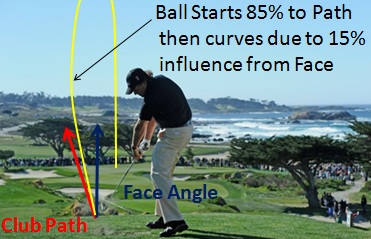
In this picture, according to the PGA Ball Flight Laws, the ball would have started in the direction of the path and then curve back to the target because of the face being aimed at impact in another direction.
D Plane
The D Plane in simplicity states "that the ball starts 85% to the club face, and has a 15% influence resulting from a club's path." You can find this information on TrackMan Page 2 of their newsletter.
The following picture will demonstrate:
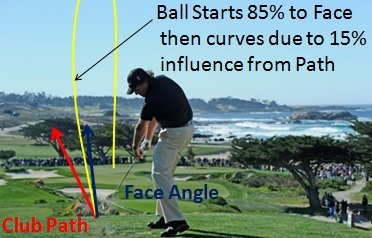
Notice the blue line is the face angle(direction in which face is aimed at impact) and the red line is the club path(direction the clubhead is moving at impact). Both of these lines point left of the target line but the difference is the face is closed to the path but open to the target line.
Since the club face is closed to the path at impact and we assume that the ball is hit with centered contact, the ball will start 85% toward the face(which is left of the target) and will then curve back to the target because of the path of the club being further left than the face.
One of the best demonstration videos out there on the d-plane is one done by James Leitz below.
In order to fully grasp the d-plane concept, you must look at how the sweetspot changes during the downswing.
As the club approaches the ball (right handed golfer) it is moving downward, forward, and outward then after it reaches the bottom of the arc known as "low point" the club head starts to move inward and upward.
The key to working the ball is being able to adjust the baseline (horizontal swing plane).
To illustrate here are two pictures:
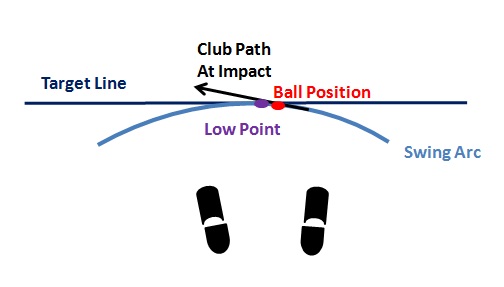
Baseline is shifted to right or ball position back
In this picture the club contacts the ball on the backside of the arc, therefore, it is moving downward, outward, and forward.
In result, the path of the club is moving to the right and if face angle is closed to the path there will be a Draw.
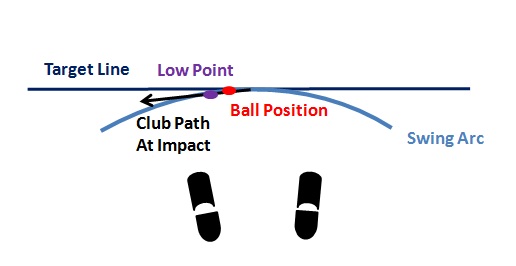
Baseline is shifted to the left or Ball position forward on arc
The second picture shows the club making contact with the ball on the forward side of the arc. This means the club is traveling inward and then upward.
In result, the path of the club is moving to the left and if the face angle is open to the path there will be a Fade.
The next time you go to the driving range or play a round of golf, be sure to watch your ball flight. By applying these principles of the d plane you will now be able to understand what is happening at impact and if needed you will be able to fix an erroneous ball flight.
Follow Us on Facebook and Twitter
We appreciate anything you can contribute to this website. We appreciate your support as we do not take your donations lightly as it helps keep our website current and fresh with information. To donate please use the button below. If you give $20 or more we will send you our free E-Book "The Major Swing Philosophies of Golf" by Bo Watson
Subscribe to our Monthly Newsletter!
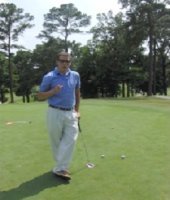 Can't find what you're looking for? Ask me over at Golf Questions and Answers Page.
Can't find what you're looking for? Ask me over at Golf Questions and Answers Page.
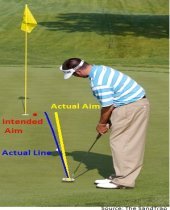 Find out why a correctly fit putter is crucial to the success of your Putting Line.
Find out why a correctly fit putter is crucial to the success of your Putting Line.
Testimonials:
Bo, I wanted to thank you for your help so far with my golf game. I wanted to let you know that I shot a 75 the other day in a tournament round, my best round ever. I had 32 total putts and NO 3 putts. I definitely couldn't have done that before. Thanks again and I'll be back in touch soon to get some more lessons lined up.
Brett
Bo I just wanted to tell you about another tournament I played in. I went out and played and shot a 75 which is one of my best rounds this year so I think everything is coming together. I've been making alot of birdies lately and just wanted to thank you for everything!
Adam Mikhalko
Hey Bo when I got back from camp I played really well I’m putting great and I’m hitting the ball well. Thank you for everything at camp.
Alvaro
Hey Bo!!! I have been playing my best in golf, mostly because of you!!! two days ago I shot an 80 in my club tourney and came in 3rd place.
Brandtley Taylor
I played in a tournament when I got back from camp and shot 76 and came in fourth. I feel much more confident on the course with my mental thoughts. I used the tips you wrote down on that sheet and they have helped me alot.
Freddy Weber





